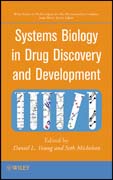
This is the first comprehensive systems biology book to focus on its applications in drug discovery and development. Using real-world examples, the book shows how systems biology can be used to enhance pharmaceutical research and drug development. It highlights essential components of drug discovery like target identification and validation and complementary systems approaches like text-mining, large multi-context datasets and regression modeling. It also provides models for treatment personalization and methods for applying systems biology to pharmacokinetics, pharmacodynamics, and candidate biomarker indentification. Introducing key methods and technical approaches the book addresses the challenges currently facing the drug industry. INDICE: Part I: Introduction to Systems Biology Approach. Chapter 1. Introduction to systems biology in drug discovery and development. 1.1 Introduction. Chapter 2. Methods for In Silico Biology: Model Construction and Analysis. 2.1 Introduction. 2.2 Model building. 2.3 Parameter estimation. 2.4. Model analysis. 2.5 Conclusions. Chapter 3. Methods in In Silico Biology: Modeling Feedback Dynamics in Pathways. 3.1 Introduction. 3.2 Statistical modeling. 3.3 Mathematical modeling. 3.4 Feedback and feedforward. 3.5 Conclusions. Chapter 4. Simulation of Population Variability in Pharmacokinetics. 4.1 Introduction. 4.2PBPK modeling. 4.3 Simulation of pharmacokinetic variability. 4.4 Conclusionsand future directions. Part II: Applications to Drug Discovery. Chapter 5. Applications of Systems Biology Approaches to Target Identification and Validation in Drug Discovery. 5.1 Introduction. 5.2 Typical drug discovery paradigm. 5.3 Integrated drug discovery. 5.4 Drivers of the disease phenotype: clinical endpoints and hypotheses. 5.5 Extracellular disease drivers: mechanistic biotherapeutic models. 5.6 Relevant cell models for clinical endpoints. 5.7 Intracellular disease drivers: signaling pathway quantification. 5.8 Target selection:dynamic pathway modeling. 5.9 Conclusions. Chapter 6. Lead Identification andOptimization. 6.1 Introduction. 6.2 The systems biology toolkit. 6.3 Conclusions. Chapter 7. The role of core biological motifs in dose-response modeling: an example with switch-like circuits. 7.1 Introduction: systems perspective indrug discovery. 7.2 Systems biology and toxicology. 7.3 Mechanistic/computational concepts in a molecular/cellular context. 7.4 Response motifs in cell signaling and their role in dose response. 7.5 Discussion and conclusions. Chapter 8. Mechanism Based Pharmacokinetic-Pharmacodynamic Modeling During Discoveryand Early Development. 8.1 Introduction. 8.2 Challenges in drug discovery anddevelopment: the need to bring together PK and PD. 8.3 Methodological aspectsand concepts. 8.4 Application during lead optimization. 8.5 Application during clinical candidate selection. 8.6 Entry into human (EIH) preparation and translational PK/PD modeling. 8.7 PK/PD for toxicology study design and evaluation. 8.8 Justification of starting dose, calculation of safety margins, and support of phase I design. 8.9 Phase I and beyond. 8.10 Support of early formulation development. 8.11 Outlook and conclusions. Part III: Applications to Drug Development. Chapter 9. Developing Oncology Drugs Using Virtual Patients of Vascular Tumor Diseases. 9.1 Introduction. 9.2 Modeling angiogenesis. 9.3 Use of rigorous mathematical analysis for gaining insight on drug development. 9.4 Use of angiogenesis models in theranostics. 9.5 Use of angiogenesis models in drug salvage: the virtual patient technology. 9.6 Summary and conclusions. Chapter 10. Systems Modeling Applied to Candidate Biomarker Identification. 10.1 Introduction. 10.2 Bioma
- ISBN: 978-0-470-26123-1
- Editorial: John Wiley & Sons
- Encuadernacion: Cartoné
- Páginas: 324
- Fecha Publicación: 13/05/2011
- Nº Volúmenes: 1
- Idioma: Inglés
